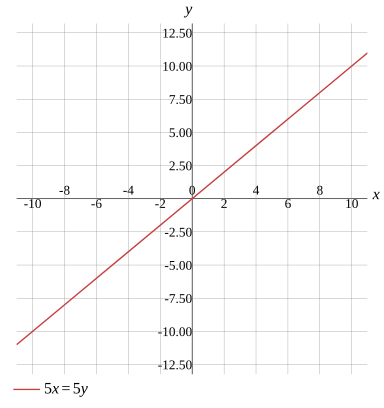Question
Function
Find the x-intercept/zero
Find the y-intercept
Find the slope
x=0
Evaluate
5x=5y
To find the x-intercept,set y=0
5x=5×0
Any expression multiplied by 0 equals 0
5x=0
Solution
x=0
Show Solution

Solve the equation
Solve for x
Solve for y
x=y
Evaluate
5x=5y
Divide both sides
55x=55y
Divide the numbers
x=55y
Solution
More Steps


Evaluate
55y
Reduce the numbers
1y
Calculate
y
x=y
Show Solution

Testing for symmetry
Testing for symmetry about the origin
Testing for symmetry about the x-axis
Testing for symmetry about the y-axis
Symmetry with respect to the origin
Evaluate
5x=5y
To test if the graph of 5x=5y is symmetry with respect to the origin,substitute -x for x and -y for y
5(−x)=5(−y)
Evaluate
−5x=5(−y)
Evaluate
−5x=−5y
Solution
Symmetry with respect to the origin
Show Solution

Rewrite the equation
Rewrite in polar form
Rewrite in standard form
Rewrite in slope-intercept form
r=0θ=4π+kπ,k∈Z
Evaluate
5x=5y
Move the expression to the left side
5x−5y=0
To convert the equation to polar coordinates,substitute x for rcos(θ) and y for rsin(θ)
5cos(θ)×r−5sin(θ)×r=0
Factor the expression
(5cos(θ)−5sin(θ))r=0
Separate into possible cases
r=05cos(θ)−5sin(θ)=0
Solution
More Steps


Evaluate
5cos(θ)−5sin(θ)=0
Move the expression to the right side
−5sin(θ)=0−5cos(θ)
Subtract the terms
−5sin(θ)=−5cos(θ)
Divide both sides
cos(θ)−5sin(θ)=−5
Divide the terms
More Steps


Evaluate
cos(θ)−5sin(θ)
Use b−a=−ba=−ba to rewrite the fraction
−cos(θ)5sin(θ)
Rewrite the expression
−5cos−1(θ)sin(θ)
Rewrite the expression
−5tan(θ)
−5tan(θ)=−5
Multiply both sides of the equation by −51
−5tan(θ)(−51)=−5(−51)
Calculate
tan(θ)=−5(−51)
Calculate
More Steps


Evaluate
−5(−51)
Multiplying or dividing an even number of negative terms equals a positive
5×51
Reduce the numbers
1×1
Simplify
1
tan(θ)=1
Use the inverse trigonometric function
θ=arctan(1)
Calculate
θ=4π
Add the period of kπ,k∈Z to find all solutions
θ=4π+kπ,k∈Z
r=0θ=4π+kπ,k∈Z
Show Solution

Find the first derivative
Find the derivative with respect to x
Find the derivative with respect to y
dxdy=1
Calculate
5x=5y
Take the derivative of both sides
dxd(5x)=dxd(5y)
Calculate the derivative
More Steps


Evaluate
dxd(5x)
Use differentiation rule dxd(cf(x))=c×dxd(f(x))
5×dxd(x)
Use dxdxn=nxn−1 to find derivative
5×1
Any expression multiplied by 1 remains the same
5
5=dxd(5y)
Calculate the derivative
More Steps


Evaluate
dxd(5y)
Use differentiation rules
dyd(5y)×dxdy
Evaluate the derivative
More Steps


Evaluate
dyd(5y)
Use differentiation rule dxd(cf(x))=c×dxd(f(x))
5×dyd(y)
Use dxdxn=nxn−1 to find derivative
5×1
Any expression multiplied by 1 remains the same
5
5dxdy
5=5dxdy
Swap the sides of the equation
5dxdy=5
Divide both sides
55dxdy=55
Divide the numbers
dxdy=55
Solution
More Steps


Evaluate
55
Reduce the numbers
11
Calculate
1
dxdy=1
Show Solution

Find the second derivative
Find the second derivative with respect to x
Find the second derivative with respect to y
dx2d2y=0
Calculate
5x=5y
Take the derivative of both sides
dxd(5x)=dxd(5y)
Calculate the derivative
More Steps


Evaluate
dxd(5x)
Use differentiation rule dxd(cf(x))=c×dxd(f(x))
5×dxd(x)
Use dxdxn=nxn−1 to find derivative
5×1
Any expression multiplied by 1 remains the same
5
5=dxd(5y)
Calculate the derivative
More Steps


Evaluate
dxd(5y)
Use differentiation rules
dyd(5y)×dxdy
Evaluate the derivative
More Steps


Evaluate
dyd(5y)
Use differentiation rule dxd(cf(x))=c×dxd(f(x))
5×dyd(y)
Use dxdxn=nxn−1 to find derivative
5×1
Any expression multiplied by 1 remains the same
5
5dxdy
5=5dxdy
Swap the sides of the equation
5dxdy=5
Divide both sides
55dxdy=55
Divide the numbers
dxdy=55
Divide the numbers
More Steps


Evaluate
55
Reduce the numbers
11
Calculate
1
dxdy=1
Take the derivative of both sides
dxd(dxdy)=dxd(1)
Calculate the derivative
dx2d2y=dxd(1)
Solution
dx2d2y=0
Show Solution

Graph
